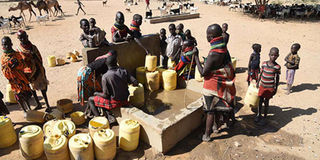Water and climate joined at the hip

Dapar villagers in Turkana County scramble for water on February 18, 2020. PHOTO | JARED NYATAYA | NATION MEDIA GROUP
What you need to know:
- Sustainable Development Goal 6 calls for clean water and sanitation for all.
- Water boiling is the leading water treatment method employed by households to improve quality.
This year’s World Water Day, which will be marked on Sunday, emphasises the link between climate and water.
We know the effects of climate change on the water cycle and, by extension, issues such as food security and livelihood sustainability.
Indeed, increases in average global temperatures are yielding damaging changes in precipitation, sparking uncommon flooding in some places and droughts in others, to the particular detriment of the world’s poorest and most vulnerable.
Yet climate change affects not just the availability of water but its quality — again, to the detriment of poor, rural households in middle- to lower-income countries, arguably the hardest-hit by these changes. Majority of the people who lack safe water are in rural areas).
WATER QUALITY
It is, therefore, important that we consider another side of the climate/water equation: How we can deliver improved water quality while being climate-friendly.
It is possible to do just that by combining innovative water treatment technology with a critical mechanism of the soon-to-expire leading global climate policy, the Kyoto Protocol: Carbon credits.
Sustainable Development Goal 6 calls for clean water and sanitation for all. However, we must recognise that not all water treatment approaches are sustainable. Some actively contribute to the degradation of the environment and proliferation of greenhouse gas emissions.
Water boiling is the leading water treatment method employed by households to improve quality. Yet it requires — particularly in rural areas — the burning of firewood or charcoal, which is financially costly for households, creates health and welfare risks related to smoke exposure and also results in broader environmental problems, such as increasing greenhouse gas emissions.
CARBON CREDITS
Conversely, water treatment methods like chlorination and filtration are safer for the environment and people’s health.
Under the Clean Development Mechanism of the United Nations Framework Convention on Climate Change (UNFCCC), a product of the Kyoto Protocol, a provision exists that encourages state and non-state actors in the developing world to initiate projects that contribute to greenhouse gas reductions. In doing so, they can generate carbon emissions savings, or “carbon credits”, that can then be sold to actors in more developed countries that may be struggling to meet their emission reduction targets.
While it has had important critiques, the provision nonetheless represents an important policy innovation: It incentivises the local and regional development of environmentally friendly programmes while encouraging governments and non-governmental organisations to integrate climate objectives with their numerous other goals.
It also engages communities in developing countries in the climate change dialogue, since organisations cannot have their credits approved without soliciting consent and feedback from the people their programmes reach.
REDUCING EMISSIONS
As a result, some water treatment programmes are leveraging this provision to meet the dual goals of reducing emissions and delivering clean water.
The UNFCCC’s Clean Development Mechanism recently approved one of the largest batches of “carbon credits” for one such organisation, Evidence Action, to the benefit of 800,000 individuals who will continue to enjoy safe water access this year thanks to revenue generated from the sale of these credits.
However, while some organisations have seen success in generating and trading carbon credits, they are relatively few.
It is difficult for organisations to take advantage of this mechanism. The biggest barriers to participation are the complexity and cost of the process.
Many organisations lack the technical expertise to navigate this complexity and, as a result, have to rely on “broker” organisations who have the know-how to facilitate success.
While incredibly helpful, these partnerships can be expensive and, therefore, either out-of-reach or not a cost-effective investment for some institutions and organisations. Additionally, the process of generating and selling credits can be extremely tedious, sometimes taking years.
GREENHOUSE EMISSIONS
For Kenya to reduce greenhouse emissions by 30 per cent by 2030, we need clear national and international market incentives that allow establishment of climate-friendly investments, trade ‘credits’ earned from such investments and plough revenue earned back into their investments. The Kyoto Protocol has demonstrated that that is possible.
It will, therefore, be critical for all Paris Agreement signatories, including Kenya, to advocate a seamless transfer of these mechanisms from the Kyoto Protocol to the Paris Agreement while maintaining ambitious emission reduction targets.
Mr Byatta @PaulByatta; Mr Ngongo @EmmanuelDennis; Ms Wangombe @juliewangombe [email protected]




